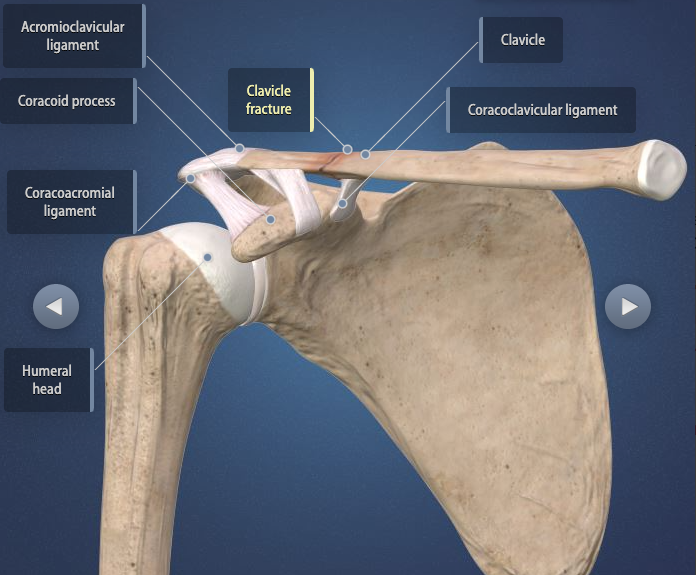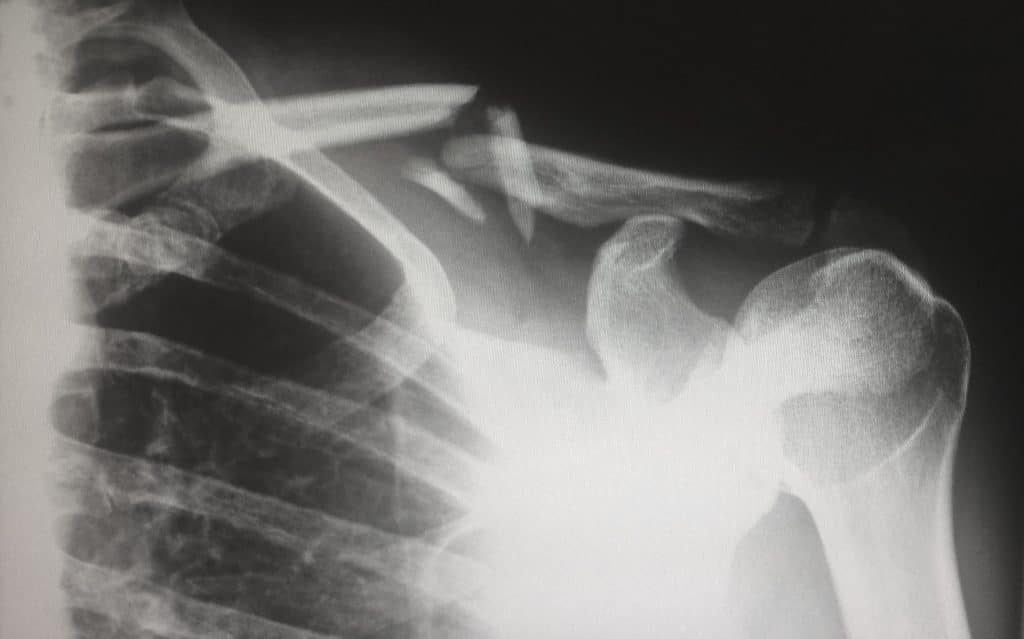Clavicle Fractures
A clavicle fracture, often called a broken collarbone, is a common injury. About five percent of adult fractures are in the clavicle.
This painful break is frequently caused by falling onto the shoulder, and it is most common in kids and young adults. A majority of broken clavicles are treated nonsurgically by wearing a sling to immobilize the shoulder. Some complicated fractures, however, require surgery.
Where is the clavicle located?

The clavicles extend off the center of the ribcage (sternum) to the shoulder blades (scapulas). They connect your arms to your body. Most people can see the ends of these slightly S-shaped bones underneath their skin, just at the base of the neck on either side of the soft spot at the throat. The collarbones are the first bones in the body to ossify (at 5 to 7 weeks in utero), yet the last bones to fully unite (in the early 20s).
Broken Collarbone Causes
The most common cause of a clavicle fracture is falling onto the shoulder. Sports collisions and car accidents are the other top causes. Broken clavicles happen most often in children and young adults, but even babies can suffer broken clavicles from passing through the birth canal.
The most common place for the clavicle to break is in the middle of the bone, called the shaft. However, some breaks do occur next to the sternum or shoulder blade attachments.
Clavicle Fracture Symptoms
A majority of broken clavicles are painful enough for you to want immediate care. You may be unable to move your arm if your collarbone is broken. Other symptoms of a fractured clavicle include:

- Bruising and swelling
- An obvious bump over the break
- A grinding or crackling sensation when trying to move the arm
- A shoulder that sags downward and looks out of place
Your orthopedic shoulder specialist will perform a physical exam and take an X-ray to determine the severity of the break and check that no surrounding nerves or blood vessels are damaged. Sometimes they use a CT scan to see the break in better detail.
Types of Clavicle Fractures
There are degrees of severity in clavicle fractures. Some breaks are simply slight cracks, and others result in the bone breaking into several pieces. Complicated breaks are called comminuted fractures. If the pieces of bone are out of place rather than aligned, they’re called displaced fractures.
The end of the broken bone may push the skin up and create a noticeable bump. Sometimes a piece of the bone breaks even breaks through the skin. The type and severity of the fracture determine the type of treatment necessary for proper healing.
Clavicle Fracture Treatment
Many clavicle fractures heal through nonsurgical methods. In these cases, you will:
- Wear a sling or splint to support the arm and keep the arm and shoulder in place
- Ice the area for about 20 minutes every 2 to 3 hours
- Take prescription pain medication and/or non-steroidal anti-inflammatory medications like aspirin and ibuprofen to help manage pain
- Perform stretching and strengthening exercises as allowed to prevent stiffness and retain range of motion
- Increase physical therapy exercises as the bone heals to regain strength lost from disuse
- See your orthopedic shoulder specialist regularly to ensure the bone is aligned and healing properly

Be aware that fractured clavicles can move out of place during the healing process. This movement could, but does not necessarily, affect healing and the need for additional treatment.
Clavicle fractures do not need to be perfectly aligned to heal properly. A fracture that heals while the bones are out of place is called a malunion. Malunions do not typically require surgery unless the bones are drastically misaligned or significantly impact your range of motion.
A fracture where the bones are out of place and not healing is called a nonunion fracture. Interestingly, some people with nonunion fractures have excellent range of motion and are not in pain. In these cases, no additional treatment is necessary. In other instances, this type of fracture is incredibly painful, and you may need surgery.
Sometimes a large bump develops over the break as it heals. While it generally gets smaller over time, some degree of bump may remain permanently, particularly in cases where the bones are not totally aligned.
Does a displaced clavicle fracture need surgery?
Some fractured clavicles require surgery, such as when the broken bone is significantly misaligned. Your orthopedic shoulder surgeon will realign the bones and use an appropriate combination of plates, pins, screws, or rods to hold the bone in place. Depending on the devices used to fixate your injury, they may be left in place post-healing or removed.
Work with your orthopedic doctor to manage pain as you heal. You will likely need pain relievers and may be given a prescription for a few days immediately following surgery. Follow your doctor’s medication directions precisely, particularly if you need opioids. They are addictive, and you should only take them for short durations.
How long does a clavicle fracture take to heal?

The time it takes to heal from a broken collarbone depends on your age, the location of the break in the bone, and how many pieces the bone is broken into. Healing could take 4 to 6 weeks for young children, 6 to 8 weeks for adolescents, and 3 to 4 months for grown teenagers and adults.
Once your injury is stable enough to begin moving, your doctor will determine which types of activities are appropriate. Moving your shoulder helps prevent issues like frozen shoulder, but too much too soon can cause problems that impede healing. With consistent dedication, you can regain the range of motion and strength you use to live an active life.
If you would like to talk to one of our orthopedic specialists or if you have questions about an injury or symptoms, please get in touch with us or comment below.
Leave a Reply